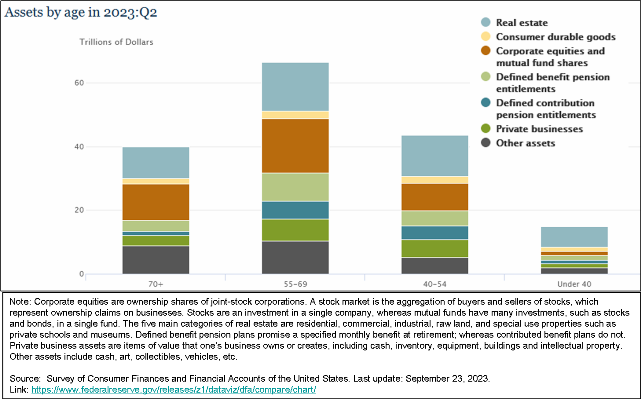The Federal Reserve provides information on the distribution of U.S. household wealth in the form of interactive charts and tables. These allow users to explore household wealth components, shares and levels across various groups and time. The information was last updated in September 2023. This post will cover wealth assets and trends by age. Here’s the chart of assets by age:
A very brief explanation of terms: the five main categories of real estate are residential, commercial, industrial, raw land, and special use properties such as private schools and museums. Corporate equities are ownership shares of joint-stock corporations. A stock market is the aggregation of buyers and sellers of stocks, which represent ownership claims on businesses. Stocks are an investment in a single company, whereas mutual funds have many investments, such as stocks and bonds, in a single fund. Defined benefit pension plans promise a specified monthly benefit at retirement, whereas contributed benefit plans do not. Private business assets are items of value that one’s business owns or creates, including cash, inventory, equipment, buildings and intellectual property. Other assets include cash, art, collectibles, vehicles, etc.
Now for the wealth-by-age trend:
Looking at the numbers, total US household wealth has risen from $21 trillion in 1990 to $165 trillion in 2023 - an eight-fold increase, with most of that wealth going increasingly to the middle-aged and older and a dwindling portion to the under-40 set (13% in 1990, 9% in 2023). Which makes sense. As I noted in the first post of this series, age at first marriage has increased by six years since 1990 and the percentage of Americans with four-year college degrees or higher has almost doubled, from 21% in 1990 to 38% in 2022. As a consequence of these trends, young adults make up more of the lower portions of the income and wealth distributions than they used to. And that’s probably ok, because all the knowledge, skills and experience they’re acquiring in their 20s will come in handy when they finally set their minds to serious wealth-building in their 30s.

